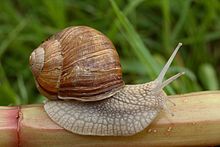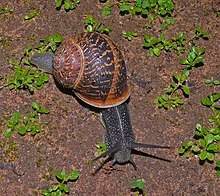Helicidae
| Helicidae | |
|---|---|

| |
| Helix pomatia | |
| Scientific classification | |
| Domain: | Eukaryota |
| Kingdom: | Animalia |
| Phylum: | Mollusca |
| Class: | Gastropoda |
| Order: | Stylommatophora |
| Superfamily: | Helicoidea |
| Family: | Helicidae Rafinesque, 1815 |
| Type genus | |
| Helix Linnaeus, 1758 | |
| Subfamilies | |
Helicidae is a large, diverse family of western Palaearctic, medium to large-sized, air-breathing land snails, sometimes called the "typical snails." It includes some of the largest European land snails, several species are common in anthropogenic habitats, and some became invasive on other continents. A number of species in this family are valued as food items, including Cornu aspersum (formerly Helix aspersa; "petit gris") the brown or garden snail, and Helix pomatia (the "escargot").[1] The biologies of these two species in particular have been thoroughly studied and documented.
Shell description
[edit]The shells are usually flattened or depressed conical. Globular shells are found in the genera Helix, Maltzanella, Lindholmia, Cornu, Cantareus, Eremina, and Idiomella. One species, Cylindrus obtusus, has a cylindrical shell. In some genera, especially in Cepaea, the shells are brightly colored and patterned.
Anatomy
[edit]Helicidae typically have a ribbed jaw, bursa copulatrix with a diverticulum, and one dart sac accompanied by a pair of (usually) branched, tubular mucous glands inserting at the base of the dart sac.[2]
Genetics
[edit]In this family, the number of haploid chromosomes lies between 22 and 30.[3]
In the "Darwin Tree of Life"." project, four species (Cepaea nemoralis, Cepaea hortensis, Cornu aspersum, and Arianta arbustorum) are scheduled for whole genome sequencing and assembly ("Data portal".).

Distribution
[edit]The core of helicids is distributed in from the Caucasus through Turkey and Europe to North Africa. However, some genera or species live beyond these limits. Helicids occur on Cape Verde[2] (Eremina), Canary Islands (Theba, Hemicycla) and the Madeira Archipelago (Lampadia, Idiomela).[4] Levantina extends far south in western Arabia, and Eremina desertella is distributed as south as Sudan, Eritrea and Puntland in Somalia.[5][6] Cepaea hortensis lives on Iceland[7] and in a small area in eastern Canada.[8] Some species, notably Cornu aspersum and Theba pisana have been introduced and become established in numerous different areas worldwide.
Taxonomy
[edit]


The family Helicidae contains 3 subfamilies (according to molecular phylogenetic analyses[9][10][11][12]):
Subfamily Helicinae Rafinesque, 1815
[edit]Genital system anatomy (does not apply on all species, as derived states are found in some of them): mucous glands divided into 2 or more branches, love dart with four blades (vanes) along its length, two penial papillae/verges.[citation needed]
Tribe Helicini Rafinesque, 1815[13]
[edit]- Aristena Psonis, Vardinoyannis & Poulakakis, 2022
- Amanica Nordsieck, 2017
- Caucasotachea Boettger, 1909
- Codringtonia Kobelt, 1898
- Helix Linnaeus, 1758 - type genus
- Isaurica Kobelt, 1901
- Levantina Kobelt, 1871
- Lindholmia Hesse, 1918
- Maltzanella Hesse, 1917
- Neocrassa Subai, 2005
A 2022 phylogenetic analysis proposed that all groups of the Maghreb radiation belonged to a single tribe, Thebini, without support for a separate Otalini tribe. The same study proposed a new tribe, Maculariini trib. nov. containing the genus Macularia due to the wide geographic disjunction between the western Alpine Macularia and the primarily Maghrebian Thebini tribe.[14]
- Cantareus Risso, 1826
- Cornu Born, 1778
- Eobania P. Hesse, 1913
- Eremina Pfeiffer, 1855
- Gyrostomella P. Hesse, 1911
- Loxana Pallary, 1899
- Massylaea Möllendorff, 1898
- Otala Schumacher, 1817
- Rossmaessleria P. Hesse, 1907
- Theba Risso, 1826
Tribe Maculariini Neiber, Korábek, Glaubrecht & Hausdorf, 2021
[edit]- Macularia Albers, 1850
Genital system anatomy (does not apply on all species, as derived states are found in some of them): mucous glands weakly branched or undivided, love dart with four blades along its length, one penial papilla.[15]
Distributed in Sardinia, Corsica, the Apennine Peninsula and Sicily.[15][16]
- Marmorana W. Hartmann, 1844
- Tacheocampylaea
- Tyrrheniberus
Genital system anatomy (does not apply on all species, as derived states are found in some of them): mucous glands divided into 2 branches or undivided, love dart with two blades on the tip, one penial papilla.[citation needed]
- Arianta Turton, 1831
- Campylaea H. Beck, 1837
- Campylaeopsis A.J. Wagner, 1914
- Cattania Brusina, 1904
- Causa Schileyko, 1971
- Chilostoma Fitzinger, 1833
- Corneola Held, 1838
- Cylindrus Fitzinger, 1833
- Delphinatia P. Hesse, 1931
- Dinarica Kobelt, 1902
- Drobacia Brusina, 1904
- Faustina Kobelt, 1904
- Helicigona A. Férussac, 1821
- Isognomostoma Fitzinger, 1833
- Josephinella F. Haas, 1936
- Kollarix Groenenberg, Subai & E. Gittenberger, 2016
- Kosicia Brusina, 1904
- Liburnica Kobelt, 1904
- Pseudotrizona Groenenberg, Subai & E. Gittenberger, 2016
- Thiessea Kobelt, 1904
- Vidovicia Brusina, 1904
- †Pseudochloritis C. R. Boettger, 1909[18]
- †Mesodontopsis Pilsbry, 1895
- †Metacampylaea Pilsbry, 1895
- †Paradrobacia H. Nordsieck, 2014
- †Pseudoklikia H. Nordsieck, 2018
Incertae sedis
[edit]- †Megalotachea Pfeffer, 1930
References
[edit]- ^ M.P. Kerney & R.A.D. Cameron. 1979. A field guide to the land snails of Britain and northwestern Europe. Collins, London.
- ^ a b Nordsieck, Hartmut (1987). "Revision des Systems der Helicoidea (Gastropoda: Stylommatophora)". Archiv für Molluskenkunde. 118: 9–50.
- ^ Thiriot-QuiéVreux, Catherine (2003). "Advances in Chromosomal Studies of Gastropod Molluscs". Journal of Molluscan Studies. 69 (3): 187–202. doi:10.1093/mollus/69.3.187. ISSN 1464-3766.
- ^ a b Neiber, Marco T.; Chueca, Luis J.; Caro, Amaia; Teixeira, Dinarte; Schlegel, Kevin A.; Gómez-Moliner, Benjamín J.; Walther, Frank; Glaubrecht, Matthias; Hausdorf, Bernhard (2021). "Incorporating palaeogeography into ancestral area estimation can explain the disjunct distribution of land snails in Macaronesia and the Balearic Islands (Helicidae: Allognathini)". Molecular Phylogenetics and Evolution. 162: 107196. doi:10.1016/j.ympev.2021.107196. PMID 33965538.
- ^ Jickeli, Carl F. (1874). Fauna der Land- und Süsswasser-Mollusken Nord-Ost-Afrika's. Dresden: E. Blochmann & Sohn.
- ^ Neubert, Eike (1998). "Annotated checklist of the terrestrial and freshwater molluscs of the Arabian Peninsula with descriptions of new species". Fauna of Arabia. 17: 333–461.
- ^ Arnason, Einar; Grant, P. R. (1976). "Climatic Selection in Cepaea hortensis at the Northern Limit of Its Range in Iceland". Evolution. 30 (3): 499–508. doi:10.2307/2407574. JSTOR 2407574. PMID 28563245.
- ^ Pearce, Timothy A.; Olori, Jennifer C.; Kemezis, Kathleen W. (2010). "Land Snails from St. Elzear Cave, Gaspé Peninsula, Quebec: Antiquity of Cepaea Hortensis in North America". Annals of Carnegie Museum. 79 (1): 65–78. doi:10.2992/007.079.0105. ISSN 0097-4463. S2CID 84205240.
- ^ Razkin, Oihana; Gómez-Moliner, Benjamín Juán; Prieto, Carlos Enrique; Martínez-Ortí, Alberto; Arrébola, José Ramón; Muñoz, Benito; Chueca, Luis Javier; Madeira, María José (2015-02-01). "Molecular phylogeny of the western Palaearctic Helicoidea (Gastropoda, Stylommatophora)". Molecular Phylogenetics and Evolution. 83: 99–117. doi:10.1016/j.ympev.2014.11.014. PMID 25485783.
- ^ a b Neiber, Marco T.; Hausdorf, Bernhard (2015-12-01). "Molecular phylogeny reveals the polyphyly of the snail genus Cepaea (Gastropoda: Helicidae)". Molecular Phylogenetics and Evolution. 93: 143–149. doi:10.1016/j.ympev.2015.07.022. PMID 26256642.
- ^ Neiber, Marco T; Korábek, Ondřej; Glaubrecht, Matthias; Hausdorf, Bernhard (2022-04-11). "A misinterpreted disjunction: the phylogenetic relationships of the North African land snail Gyrostomella (Gastropoda: Stylommatophora: Helicidae)". Zoological Journal of the Linnean Society. 194 (4): 1236–1251. doi:10.1093/zoolinnean/zlab059. ISSN 0024-4082.
- ^ a b Holyoak, David T.; Holyoak, Geraldine A.; Gómez Moliner, Benjamín M.; Chueca, Luis J. (2020). "Phylogeny, species-limits and taxonomic revision of the Otalini (Helicidae) from north-west Africa". Journal of Conchology. 43: 551–611.
- ^ Korábek, Ondřej; Juřičková, Lucie; Petrusek, Adam (2021-12-31). "Diversity of Land Snail Tribe Helicini (Gastropoda: Stylommatophora: Helicidae): Where Do We Stand after 20 Years of Sequencing Mitochondrial Markers?". Diversity. 14 (1): 24. doi:10.3390/d14010024. ISSN 1424-2818.
- ^ a b Marco T Neiber; Ondřej Korábek; Matthias Glaubrecht; Bernhard Hausdorf (2022). "A misinterpreted disjunction: the phylogenetic relationships of the North African land snail Gyrostomella (Gastropoda: Stylommatophora: Helicidae)". Zoological Journal of the Linnean Society. 194 (4): 1236–1251. doi:10.1093/zoolinnean/zlab059.
- ^ a b Hesse, Paul (1908). Iconographie der Land- & Süsswasser-Mollusken mit vorzüglicher Berücksichtigung der Europäischen noch nicht abgebildeten Arten. Neu Folge. Vierzehnter Band. Wiesbaden: C. W. Kreidel.
- ^ Fiorentino, Viviana; Salomone, Nicola; Manganelli, Giuseppe; Giusti, Folco (2010). "Historical biogeography of Tyrrhenian land snails: The Marmorana–Tyrrheniberus radiation (Pulmonata, Helicidae)". Molecular Phylogenetics and Evolution. 55 (1): 26–37. doi:10.1016/j.ympev.2009.11.024. PMID 19995610.
- ^ Groenenberg, Dick S.J.; Subai, Peter; Gittenberger, Edmund (2016-01-28). "Systematics of Ariantinae (Gastropoda, Pulmonata, Helicidae), a new approach to an old problem". Contributions to Zoology. 85 (1): 37–65l. doi:10.1163/18759866-08501003. ISSN 1383-4517.
- ^ Höltke, Olaf; Rasser, Michael W (2015). "Pseudochloritis insignis–a peculiar large land-snail from the Miocene of SW Germany: taxonomic status and census of morphologically related forms". Journal of Conchology. 42 (1): 1.
